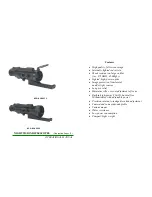
6
3. Retighten the counterweight lock knob. The telescope is now
balanced on the R.A. axis.
4. To balance the telescope on the Dec. axis, first tighten the
R.A. lock knob, with the counterweight shaft still in the hori-
zontal position.
5. With one hand on the telescope optical tube, loosen the
Dec. lock knob (see
Figure 6
). The telescope should now
be able to rotate freely about the Dec. axis. If the front of the
telescope swings downward on its own (
Figure 9C
), that
means you need to move it back in the mount’s saddle. If
the front of the telescope swings upward, then you need to
shift the telescope forward in the saddle. To move the tele-
scope in the saddle, while holding the optical tube securely
in one hand, loosen the saddle lock knobs just a little – so
the dovetail bar doesn’t accidentally pop out of the saddle.
Position the telescope so it remains horizontal when you
carefully let go with both hands (
Figure 9D
). This is the bal-
ance point. The tube can also be moving forward and back-
ward in the rings themselves instead of sliding the dovetail
bar forward and back.
6. Retighten the saddle clamp knobs, and/or tube rings if nec-
essary.
The telescope is now balanced in both axes. Now when you
loosen the lock knob on one or both axes and manually point
the telescope, it should move without resistance and should
not drift from where you point it.
V. Using the EZ Finder II
finder scope
Operation
The EZ Finder II works by projecting a tiny red dot (it's not a
laser beam) onto a lens mounted in the front of the unit. When
you look through the EZ Finder II, the red dot will appear to
float in space, helping you locate even the faintest of deep
space objects. The red dot is produced by a light-emitting
diode (LED) near the rear of the sight. A 3-volt lithium battery
provides the power for the diode.
Figure 10.
Features of the EZ Finder II.
Power knob
Red LED
Battery cover
Tab
Altitude
adjustment
knob
Azimuth
adjustment
knob
Big Dipper
(in Ursa Major)
Little Dipper
(in Ursa Minor)
N.C.P.
Polaris
Cassiopeia
Figure 11.
To find Polaris in the
night sky, look north and find the
Big-Dipper. Extend an imaginary line
from the two “Pointer Stars” in the
bowl of the Big Dipper. Go about five
times the distance between those
stars and you’ll reach Polaris, which
lies within 1° of the north celestial
pole (NCP).
Point
er St
ars
Figure 12.
Adjusting tripod legs
































